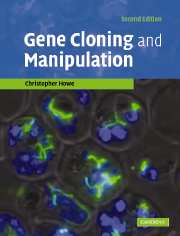Book contents
- Frontmatter
- Contents
- Preface to first edition
- Preface to second edition
- Chapter 1 The tools for the job
- Chapter 2 Polymerase chain reaction
- Chapter 3 Simple cloning
- Chapter 4 Other vector systems for E. coli
- Chapter 5 Making libraries
- Chapter 6 Screening libraries
- Chapter 7 Modification and mutagenesis
- Chapter 8 Use of cloned DNA
- Chapter 9 Using other organisms
- Chapter 10 Examples
- References
- Index
Chapter 4 - Other vector systems for E. coli
Published online by Cambridge University Press: 05 June 2012
- Frontmatter
- Contents
- Preface to first edition
- Preface to second edition
- Chapter 1 The tools for the job
- Chapter 2 Polymerase chain reaction
- Chapter 3 Simple cloning
- Chapter 4 Other vector systems for E. coli
- Chapter 5 Making libraries
- Chapter 6 Screening libraries
- Chapter 7 Modification and mutagenesis
- Chapter 8 Use of cloned DNA
- Chapter 9 Using other organisms
- Chapter 10 Examples
- References
- Index
Summary
Introduction
So far, we have considered the use of small plasmids as cloning vectors for E. coli. However, these are not the only molecules able to replicate inside bacterial cells. For example, the E. coli F (fertility) factor is a large plasmid that can replicate independently of the bacterial chromosome, like other plasmids (although it can also insert itself into the bacterial chromosome). The F factor is used as the basis of bacterial artificial chromosome (BAC) vectors, for cloning very large pieces of DNA. Bacteriophage viruses are also able to replicate inside the bacterial cell, and a number of them have been developed for use as cloning vectors. These include the phages M13, lambda, Mu and P1. The M13 vectors have a lot in common with the pUC vectors we looked at in Chapter 3. They can be used for generating single-stranded DNA and they have been particularly useful in DNA sequence determination, although they are now less widely used for this. The lambda vectors are used for more general cloning purposes. Phage Mu is often exploited for its ability to act as a transposable genetic element, and Phage P1 is particularly useful for the production of phage artificial chromosomes (PACs). Like BACs, these can be exploited for the cloning of very large pieces of DNA. There are also a selection of vectors that are hybrids between plasmids and phages.
- Type
- Chapter
- Information
- Gene Cloning and Manipulation , pp. 74 - 97Publisher: Cambridge University PressPrint publication year: 2007



